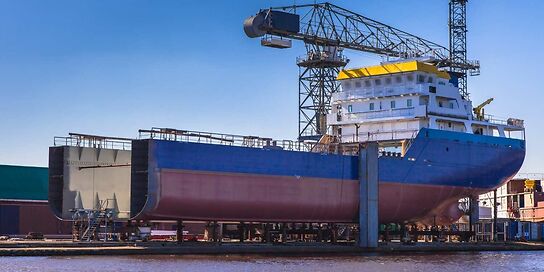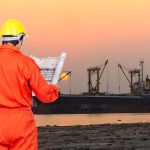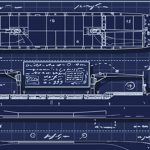The Shipbuilding Industry Has Over The Years Developed The Construction Of Ships With Hulls And Structures In Steel.
For Some Decades Now Other Construction Materials, Such As Metal Alloys, Have Been Introduced. Aluminium Alloys Have Been Widely Used In The Construction Of Light, Small-Sized Vessels, While Special Metals Such As Titanium Have Been Used In Particular Cases. These Are Not Currently Used On An Industrial Scale And Are Therefore Not Included In This Study.
The Manufacturing Process For Steel Or Aluminium Vessels Is Similar And Therefore One Description Is Given For Both Processes. The Greatest Differences Are Those Inherent In The Difference In Vessel Size: Aluminium Vessels Have A Much Smaller Volume Than Steel Vessels. The Sheet Metal Used Is Therefore Thinner And Can Be Cut, Bent And Soldered More Easily Than That Used In The Construction Of Large Steel Ships.
Apart From Requiring Great Skill In Metal-Working Techniques, The Construction Of A Ship Also Calls For Professionalism And Knowledge Of Numerous Technical Sectors, Such As Erection Of Scaffolding For Constructing The Hull And Plating, Electrical Wiring, Raising And Moving Operations, Sandblasting, Cleaning And Painting And All The Details Of Fitting-Out.
The Manufacturing Cycle In Metalworking Shipyard.
The Variety Of Manufactured Products Which Go To Make Up A Fitted-Out Vessel Is Enormous And Entails A Wide Range Of Different Materials; These Include Semi-Worked Products Such As Metal Sheeting And Sections, Finished Products Such As Engines And Items For Fitting-Out Which Vary According To The Type Of Ship, Be It A Petrol Or Dangerous Substance Carrier, A Passenger Ship Or A Cruise Ship.
The Following In Particular Are Required: Joinery And Insulation Materials, Products For Sandblasting, Cleaning And Painting, Gas And Electrodes For Soldering And Welding And Oils For Tool Machines.
On Arrival Material Is Offloaded From The Relevant Means Of Transport (Transport Is By Sea Or Land Depending On The Size Of The Material), Checked And Then Stored In A Warehouse.
This Study Refers Primarily To The Construction Of A Vessel Which Has A Supporting Structure Made In Steel. Where This Differs From Construction Using Other Metal Alloys, The Difference Is Noted.
Movements Depend On How The Shipyard Is Laid Out.
Materials Are Divided Between The Various Departments On The Basis Of The Work Cycle. In The First Place The Sheet Metal And Sections Are Delivered To The Naval Workshop And Then The Rest Of The Material Is Delivered To The Relevant Departments. Large Shipyards Have A General Warehouse Which Houses Materials Of General Use.
Sheet Metal And Other Bulky Goods Are Moved Using:
· Gantry Cranes On Rails,
· Cranes On Wheels,
· Fork Lift Trucks,
· Wheeled Trucks.
The Naval Workshop Can Be Considered The Starting Point In The Manufacturing Cycle. Here The Sheet Metal And Sections That Will Be Used In Constructing The Hull, The Plating, And Internal And External Structures Are Laid Out, Cut And Formed.
Cutting Operations Are Always Preceded By Tracings, And Are Carried Out In Different Ways Depending On The Material Used, The Size Of The Steel Plate And The Shape That Is To Be Cut. Mechanical Cutting Is Carried Out By Machine Tools And Is Followed By Cleaning Of The Sheet Metal To Remove Any Off-Cuts. Oxygen Cutting, Whether Using Oxy-Propane, Oxy-Acetylene Or Plasma Is Carried Out By Specialised Operatives Either With The Help Of A Pantograph Or By Hand Using A Simple Etcher. Each Type Of Cut Requires Particular Machinery And Tools Along With Appropriate Systems For Moving The Piece (Small Cranes, Hoists Etc.) Towards The Machine.
After Each Cutting Operation The Work Area Must Be Cleaned Of Off-Cuts And Waste. Prefabrication Of Non-Heavy Rough Pieces Is Begun In The Naval Workshop And Sheet Metal And Sections Are Put Together Here.
Finishing Operations Carried Out In The Naval Workshop Include The Moulding Of Semi-Worked Products Which Are Then Delivered To The Various Departments. These Pieces May Be Used For New Assembly Of Both Small And Large Pre-Fabrications As Well As Directly On The Stocks.
The Mechanical Workshop Features In Many Manufacturing Cycles As It Produces All The Elements For Installing Machinery On Board, Such As Supports, Joints, Anti-Vibration Couplings, Pipe Work, Valves And Pumps.
Numerous Operations Are Carried Out Here, Such As Cutting, Moulding, Welding, And Cleaning And Sandblasting Of The Metal Parts Which Form Part Of The Machinery On Board.
The Mechanical Workshop Also Carries Out Maintenance Work Of On-Site Machinery, Lifting Mechanisms And Operating Machinery.
In Large Shipyards The Mechanical Workshop Has Specified Departments For Working Pipes And For Welding Easily-Transportable Pieces.
Small Pre-Fabrication Involves The Assembly, Where Necessary By Welding, Of Sheet Metal And Pipe Work To Form Small-Sized Pieces Such As Walkways Etc. The Welding Is Either Done Electrically Or Using Gas In Inert Atmospheres.
The Main Aim Of Large-Scale Pre-Fabrication, Which Can Be Done Both In Parallel Or In Series With Small Pre-Fabrication, Is The Construction Of Semi-Worked Items Which Make Up Elements In The Base Structure And Plating. When Assembled With The Appropriate Walls Of Insulation And Sound-Proofing This Type Of Pre-Fabrication Can Produce Almost Complete “Blocks” Which Are Then Used To Construct The Ship.
Interiors Are Made Of Wood Which Comes From The Ship-Yard Carpenters And From Other Materials Which Are Previously Worked In The Appropriate Department. The Materials Used Must Retain Their Characteristics In A Marine Environment.
Different Blocks Of The Ship Are Then Constructed Contemporaneously In Different “Islands”, Thus Providing For Better Work Organisation And Most Importantly Reducing The Overall Construction Time.
Work From The Ground Is Carried Out Using Safety Platforms, Parapets, Scaffolding, Elevator Platforms And Cranes, All Of Which Are Essential For Working At High Level On The Blocks. As Work Progresses It Becomes Necessary To Work In Restricted Spaces, Particularly When Carrying Out Interior Work On Small Cabins Carved Out Of The Block.
After Assembly, Which Is Once More Accomplished By Welding, The Parts Are Then Sanded, Using Jets Of Sand Directed At The Metal Surfaces. This Simultaneously Cleans And Primes. The Cleaned Surface Is Then Covered With A Protective Paint, Or Primer, Which Preserves It Against The Oxidising Effect Of Damp Air And Other Aggressive Agents. These Operations Are Carried Out In A Different Place To That Where The Item Was Constructed, And It Is Therefore Necessary To Move The Blocks On Trolleys Or Cranes To The Sheds Which Are Specially Equipped For Such Operations.
The Completed Blocks Are Then Assembled On The Stocks With The Help Of A Bridge Crane. The Stocks May Consist Either Of Two Large Slipways Or By A Dock With An Opening Towards The Sea. The Various Blocks Are Fixed Together And Then Welded, Thus Creating The Vessel.
In Addition To Assembly, During This Phase Many Of The Other Operations Which Render The Vessel Operative Are Carried Out.
During The Phase Of On The Stocks Construction All The Internal And External Finishing Operations Are Carried Out On The Hull In Order To Guarantee That The Vessel Will Float And To Complete The Parts That Will Be Under Water Following The Launch.
Tests Are Carried Out On The Hydraulics, The Electrical Wiring System, And, Under Pressure, On The Pipe-Work And Tanks, Particularly For Those Ships Which Are To Be Used For The Transport Of Pressurised Liquids.
The Final Operations Prior To Launch Are Those Of Cleaning And Painting Of The Hull. It Should Be Pointed Out That All The Construction Operations Described Above, Such As Welding During The Assembly Of The Blocks And Cleaning And Painting, Involve The Use Of Platforms And Scaffolding For The Workers And Hoists For The Machine Tools Used.
Launching Operations Depend On The Type Of Stocks Used. In Practice, When The Vessel Is Mounted On A Slip-Way The Stops Are Removed And The Ship Is Left To Slide Into The Sea. When The Vessel Has Been Assembled In Dry-Dock, The Dock Is Filled With Water.
Operations Of Loading And Installing Machinery And Fitting-Out Can Be Carried Out Both On Solid Ground (On The Stocks) And After Launching. In General It Is Better To Carry Out These Operations On Solid Ground, Particularly For Work Which Must Be Done In Limited Space Or Where Communication Hatches Leading To Adjacent Areas Are Restricted. These Works Include Finishing Operations And All Other Auxiliary Services Carried Out With The Aim Of Making The Ship Fit For Navigation. Some Of The Most Important Of These Are The Services For Dealing With Situations Of Flood Or Fire, Those Intended For The Crew Or Passengers (Bunks, Kitchens Etc), Navigational Services, Such As Command And Route-Finding Equipment, And Services Connected To The Distribution Of Electricity Produced By The Auxiliary Generator Which Runs On Engine Or Turbines.
During Fitting-Out Plant And Machinery Are Completed And Tested. The Cabins Are Painted And The Last Finishing Operations Are Finalised.
The Last Phases Of The “Manufacturing Cycle” Are Sea Trials, Which Are Essential For Testing The Propulsion System, Operability, And Control Equipment And Safety Systems For Navigation, Both For Crew And Passengers. In General A Preliminary Trial Is Carried Out Prior To The Official One.
Before Delivery The On-Board Equipment Is Loaded.
To Summarise The Description Of The Production Of A Ship It Is Possible To Sub-Divide The Activity Into Two Major Processes; Actual Construction Of The Vessel And Its Fitting-Out. Operations Begin With Construction But As Work Proceeds The Two Activities Are Carried Out Together. The Greatest Difference Between These Two Operations Is In The Place In Which They Are Carried Out; Construction Operations Are Often Done In Open Areas, With The Help Of Cranes And High-Level Platforms. Only Rarely Is It Necessary To Work In Closed Places Such As Cabins Inside The Vessel, Which Are Narrow, Badly Lit And With Few Exits. All The Fitting-Out Operations However Are Carried Out Inside The Ship In Restricted Spaces.


